Best Beach Destinations in Italy
Introduction
Surrounded on three sides by water and with two offshore islands larger than some countries, it’s no wonder Italy is famed for its beaches. Whatever your taste in beach resorts, you’ll likely find it somewhere here. The Mediterranean, the Adriatic, and several smaller seas lap long stretches of fine golden sand. Beaches in little secluded coves are guarded by rocky headlands that hide them from all but those who know where to look. Europe’s tallest dunes protect white beaches that are nearly empty, even in August. The walls of medieval towns look down on sandy strands, and Art Nouveau resort towns are redolent of Belle Epoch’s gentility. Take your pick. Join crowds in the boisterous fun of unabashedly overcrowded scenes at Viareggio, Rimini, or Lido in Venice—or take a local boat to your private pink-sand cove off the fabled Costa Smeralda in Sardinia. Stretch out on a sunbed at the private beach of a luxurious resort hotel or slip into something chic and saunter along Italian Riviera promenades where royalty once strolled. You’ll find all these and more along Italy’s 7,600-kilometer coast. Plan your time by the sea with our list of the top beach destinations in Italy.
Destinations
Costa Sud and Costa Verde, Sardinia

Southwest of Sardinia’s capital of Cagliari, SP 71 winds through spectacular scenery of promontories and islands. Sandy beaches hide in coves between headlands topped by round towers built when western Sardinia was under Spanish control. A World Wildlife Fund reserve protects birds, wild boar, and indigenous deer in the mountains behind. Three miles of beach at Porto Campana has plenty of space, with remote sections and places to rent equipment and take lessons in kiteboarding, paddle boarding, and even scuba diving in the crystal waters. Stay at the five-star Faro Capo Spartivento hotel in a former lighthouse with spectacular sea views. The coast swings north to the almost deserted white sands of the Costa Verde, where a broad plain separates the sea and mountains. These are some of Sardinia’s longest, least-used, and most beautiful beaches, where even in August, you’ll find long stretches of empty sands. Behind the beaches lie the Dune di Scivu, among Europe’s tallest dunes. One of Europe’s top thalassotherapy centers is at the Forte Village Resort in Pula, where natural seawater is used for therapy. The primary archeological site of Nora is at the end of a beautiful nearby beach. Nora is today a vast open-air museum of Sardinian antiquity built by Phoenicians, with remains of its Roman and Phoenician past. Toppled walls of massive Roman baths tower over the street, and the Roman theater is still used for summer performances. Where else can you find a world-class ancient city at the end of a beautiful white-sand beach?
Cala Goloritzé
Nestled south of Cala Biriola in Sardinia, Cala Goloritzé is a tiny beach with soft sand and limestone cliffs. This beautiful beach is one of the most photogenic destinations in the region and is accessible by car and boat. However, those planning to visit Cala Goloritzé should know that hiking to the beach from the nearest road takes approximately 90 minutes! Bring your snorkeling equipment, as the waters here are crystal clear. This is probably one of the best beaches for snorkeling in Sardinia. No wonder this place was included in the list of UNESCO sites in 1995.
The Salento, Puglia
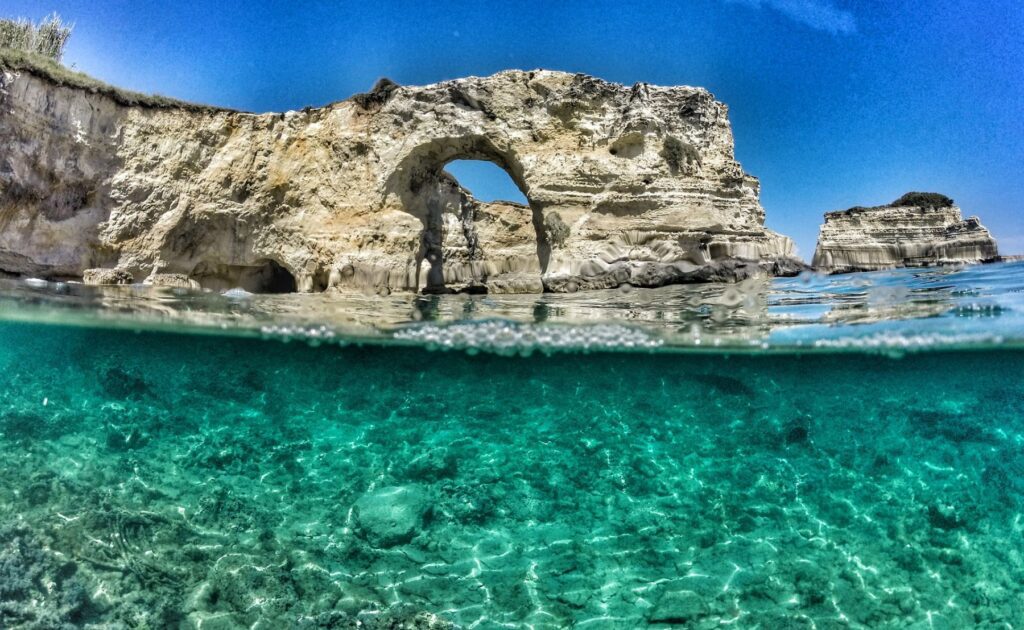
Puglia forms the heel of Italy’s boot-shaped map, and at the very tip of the heel is the even-less-visited Salento, where the Adriatic and Ionian seas mingle off a sublime and largely pristine coast. Rocky cliffs and headlands separate deep coves and inlets that hide tiny beaches along the eastern shore, protected by the Parco Naturale Regionale Costa Otranto. Picturesque little Otranto on its headland has only a small beach, but stop to see the 12th-century church mosaics before heading north to the pristine blue-flag beaches on Baia dei Turchi, in the nature reserve. South of Otranto are more sandy coves between here and Santa Maria di Leuca at the tip of the heel. West of Santa Maria di Leuca are some of Italy’s most beautiful beaches, kilometers of glorious golden sand broken by occasional rocky promontories. Beyond the rocky Punto del Pizzo, where the Gulf of Gallipoli begins, are even more long beaches backed by pines. Historic Gallipoli’s long beach begins right beneath its walls. Park-protected, pine-bordered, in-town, or caught between soaring headlands, you can choose beach style in the Salento. A good base is the family-owned Masseria Salinola in Ostuni, built in the sixteenth century and surrounded by century-old trees.
Otranto Beach
Known for its turquoise waters and soft white sand, Otranto Beach is nestled in the easternmost town in the country, Otranto. Head to this small, historic seaside town for fine wine and delicious Italian cheeses. Otranto Beach is perfect for numerous water activities, such as snorkeling, sunbathing, and swimming. While doing so, admire the fantastic cliffs that make Otranto Beach one of the most beautiful beaches in Puglia. Regarding accommodation options in Otranto, expect to find everything from apartment rentals to high-end resorts and hotels. There are also dozens of restaurants and bars where you can try some of the freshest seafood and Italian pasta.
Capo Testa and the Maddalena Islands, Sardinia
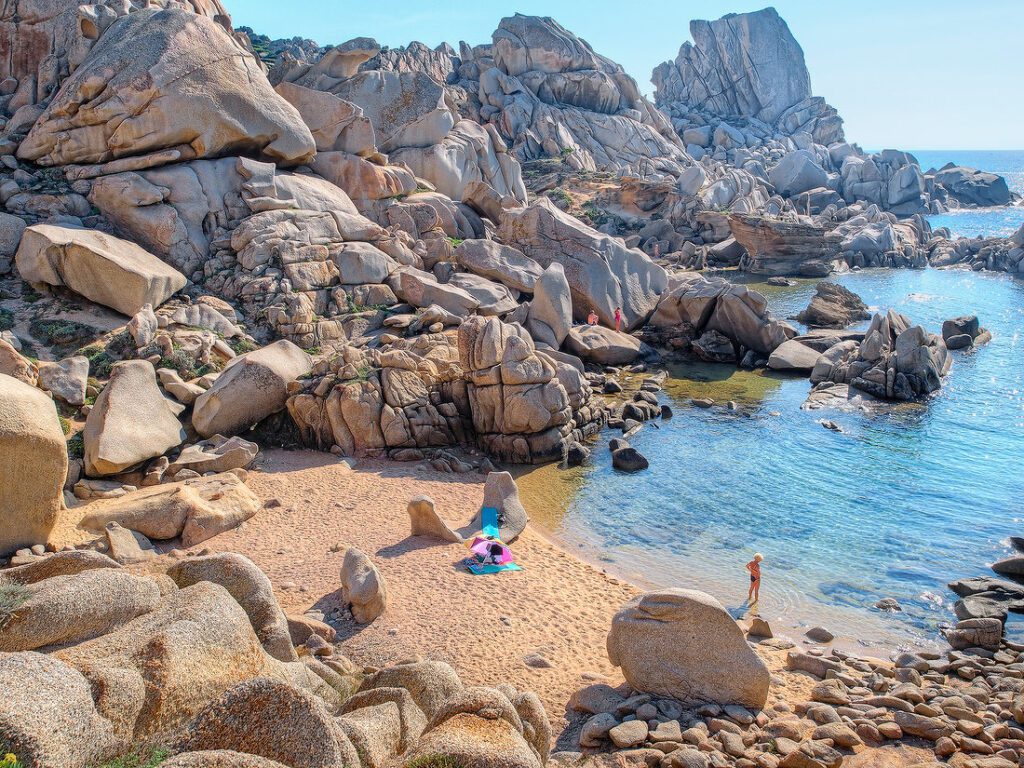
While nearly all the beaches on Sardinia’s fabled Costa Smeralda are either private or only accessible by private boat, these same emerald waters lap the equally beautiful beaches around neighboring Capo Testa and the Maddalena Islands. The cape’s fantastically shaped cliffs and rock outcrops are a continuation of the mountain landscapes of Gallura that rise behind them, sculpted by millennia of winds. If you prefer pink instead of white sands to contrast the water, hop aboard a ferry to the adjacent Maddalena Islands for more beaches. Once here, if you don’t want to share the sand, local boats will take you to your private island and pick you up later. Cala Granara, on Isola di Spargi, is the most idyllic, its soft white sands backed by palms and tropical foliage. Bring your towels, umbrella, and refreshments, as most beaches are undeveloped. For off-beach excursions, visit some of the region’s fascinating prehistoric sites in and around nearby Arzachena. Set in tree-shaded grounds overlooking the turquoise waters between Cala Capra and Cala Selvaggia, Hotel Capo D’Orso Thalasso & Spa offers boat rides to secluded cove beaches.
San Vito Lo Capo, Sicily
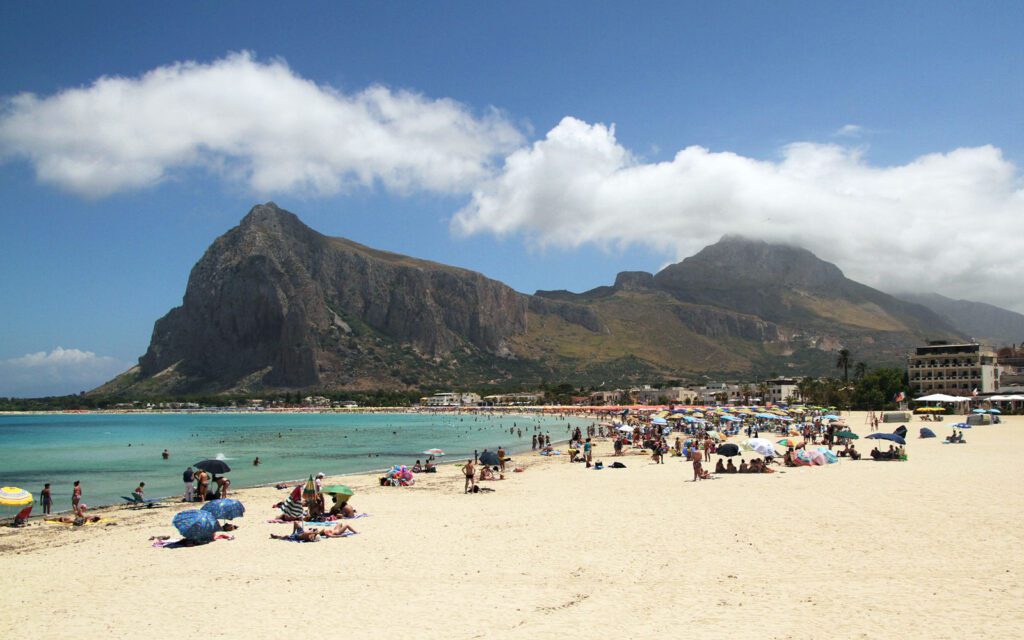
Its palm trees, powdery white sand, and crystal-clear blue water make this long crescent near Trapani look much like the Caribbean. Bounded by the soaring rock headland of Monte Monaco, the wide beach of San Vito Lo Capo is adjacent to the Zingaro Nature Reserve on Sicily’s northwestern coast. The little resort town—don’t expect a quaint fishing village, as it’s mainly modern—is lively in the summer. Still, the area is not over-run despite its popularity with Italian families. You can reach San Vito Lo Capo by public bus from Trapani and Palermo. It is somewhat remote at the end of a cape, so this is not a good base for touring. Do as the Italians do: settle in for a few days to enjoy the sand, the sun, and the warm, sheltered waters; the luxury Hotel Capo San Vito sits right above the beach. You can follow the hiking trails through the nature reserve for beautiful views, take a boat for sightseeing, or discover secluded pebble beaches.
Capreria Beach
Nestled at the far end of the western coast of Sicily, Riserva Naturale dello Zingaro is the only nature reserve in the region that features six kilometers of amazing coastline. What makes this area so unique is that no modern developments are built here so that you will find nothing but native plants and wildlife. Visit the fabulous Capreria Beach with small pebbles and crystal-clear waters. You won’t see any facilities on the beach, but that’s a small price to pay for a perfect snorkeling destination. Get out and explore dozens of small caves and coves close to Capreria Beach and discover the colorful fish through a network of water trails.
Elba
The jagged coastline of Elba, an island off the coast of Tuscany, is dotted by more than 150 beaches, from long sandy stretches to tiny shingle beaches hidden in coves. While the main beaches can be very crowded in summer, you’ll find more space at Sant’Andrea without losing any amenities, including parasols, lounge chairs, and eating places. For water sports, you can rent windsurfers and boats here; the protected waters are relatively shallow. The beach at Sansone is a mix of sand and smooth pebbles that slopes gently into the sea, a good choice for families with small children. The beach at Forno is in a cove surrounded by lush greenery. Biodola and the other extensive beaches are less crowded during spring and fall, from late May through early June and September. Ferries to Elba leave from the port of Piombino, on the Tuscan coast south of Livorno. The island has an excellent local bus service.
Campo all’Aia Beach
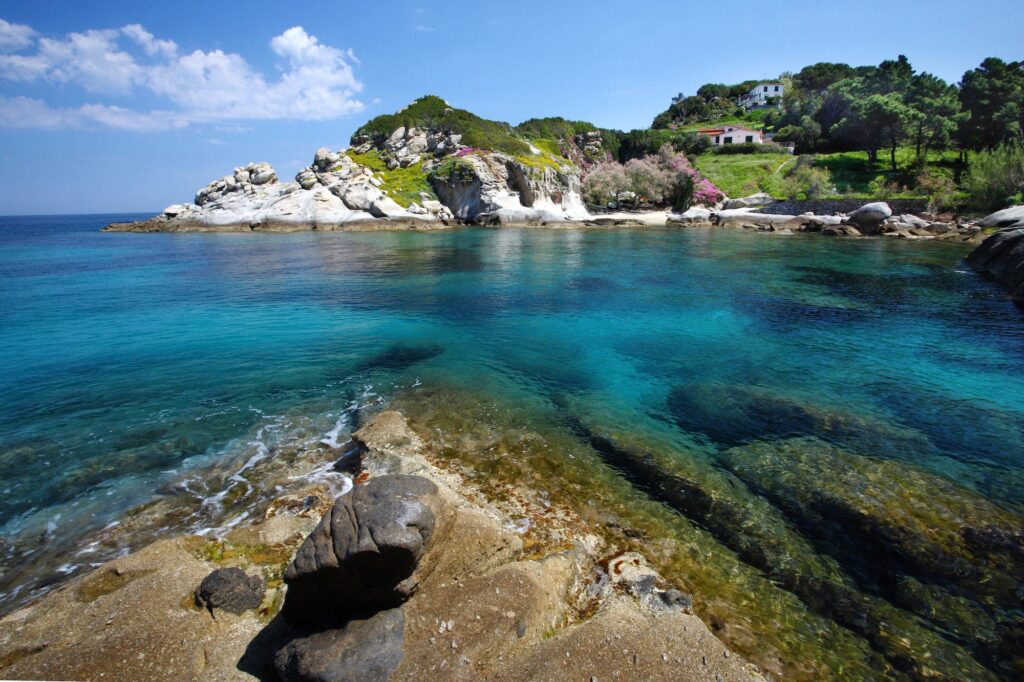
The longest beach on the famous Elba Island, Campo all’Aia, is a sheltered beach with a vast stretch of fine sand. Families with children love to come here because the beach is perfect for swimming, and even regular swimming lessons are available. Views of La Guardiola are fantastic from here, and you can also use the small bridge if you want to check out nearby Procchio Beach. Vacationers can rent umbrellas and sunbeds at the beach bar, serving local fish for lunch and various refreshing drinks. What’s excellent about Campo all’Aia Beach is that it doesn’t get as crowded as the neighboring beach of Procchio, so it’s easy to find your private patch in the sand.
Isola Bella
A small island close to Taormina in Sicily, Isola Bella is located in the middle of a small bay and is well-known for its beautiful plants and warm, calm waters. This beach is trendy among travelers because of the fantastic views of the Ionian Sea and its crystal-clear blue waters. The great thing about Isola Bella is that the bay protects it, so conditions for water activities such as swimming, snorkeling, and paddle boarding are ideal. You can access the island by walking across a path that connects the mainland or by a small cable car that runs from Taormina to Mazzaro.
Sanremo
At the heart of the fabled Italian Riviera is Sanremo, made famous as a watering hole for royalty, nobility, the wealthy, and wannabes who gathered here in the early 20th century. Empress “Sisi” of Austria and Emperor Nicholas II of Russia enjoyed its year-round balmy climate and added to its glamorous allure. Wealthy visitors built Art Nouveau villas and gardens that still line its streets. Its old town, where houses date from medieval times, is a warren of winding alleys and passageways designed to foil marauding pirates. Today’s boat traffic is more in the line of wealthy yacht owners. Grand hotels from the Belle Epoch, such as the luxury Royal Hotel Sanremo, line the palm-shaded esplanade and hillside above its in-town beach. The climate has also led to Sanremo becoming one of Europe’s major flower-growing centers, and the fragrance of blossoms hangs in the air, adding to its aura of old-world gentility. Some of the best beaches of the Ligurian coast are between Sanremo and San Lorenzo to the east. Most are accessible and much less crowded than the Riviera beaches closer to Genoa, and they are connected by a 25-kilometer bicycle path created from the former seaside rail line. Many hotels provide guests with bicycles.
Ischia

Ancient Greeks and Romans frequented the volcanic island of Ischia, in the Bay of Naples, to bathe in its hot springs amid its luxuriant flora. The best known of Ischia’s fabled beaches is Spiaggia dei Maronti, in the south near the postcard village of Sant’Angelo. Along with good swimming, its three kilometers of sand give access to open-air pools of a thermal spring. Also popular is the Spiaggia Citara, where the elegant gardens of a high-end thermal spa overlook the beach. Several others are along its 37-kilometer coast, but the large ones are crowded in the summer (Ischia is particularly popular with German tourists), and much of the sand is covered with rows of umbrellas and sun lounges for rent. Taking a water taxi to one of the many secluded coves with more minor, uncrowded beaches in high season is worth taking. The little island of Procida is even more picturesque and easy to reach by boat. You can get to Ischia from Naples harbor by ferry.
Santa Margherita Ligure
There’s a feeling of stepping back into another era in Santa Margherita Ligure. The town recalls when ladies and gentlemen spent seaside holidays in the sophisticated surroundings of candy-colored grand hotels, sipping lemonade on the verandahs or under sedate rows of palm trees, dressing for dinner, and taking an evening stroll along the esplanade above the beach. Of course, that’s not precisely what beach-goers do there now, but the old-fashioned atmosphere is still suitable. Please don’t choose this resort town for miles of sand but for its old-world charm, comfortable hotels (the Lido Palace Hotel is a classic, with balconies overlooking the beach), excellent seafood restaurants, and air of gentility. The town is worth exploring. Its Baroque church, Santuario di Nostra Signora della Rosa, is lavishly decorated with frescoes and gilded carvings. Climb the narrow streets to the little Castello and the terraced gardens of 17th-century Villa Durazzo, now a public park with fountains and statues set among the greenery. Admire the classy yachts in the harbor and watch the fishing boats unload in the morning, or take one of the frequent ferries to pretty Portofino.
Viareggio

In August, when the streets of Milan, Genoa, and Florence all seem to have emptied onto this 15-kilometer stretch of Mediterranean beach, it may be hard to find the sand for the sea of umbrellas. Whether or not this scene is to your taste, there’s no denying it’s an authentic Italian beach experience. Apart from the small and hard-to-find public beach at the south end, nearly every inch of sand is reserved for those who have rented their space from the hotel, restaurant, or lido operator that manages it. Extended families, groups of friends, and even entire neighborhoods rent their adjacent parasols and lounge chairs and spend their days here. As shadows lengthen, the buzz moves to the Belle Époque promenade for the evening passeggiata, past fashionable boutiques and designer shops. Cittadella Jazz & More concerts draw crowds from mid-June through mid-August. Out of season, Viareggio is quiet, except in February when it’s the scene of one of Italy’s wildest and most colorful Carnival parades. Unless you plan to trek to the public area, it’s wise to reserve a hotel overlooking the beach. For the whole Viareggio experience, the moderately priced Hotel Villa Tina occupies an original Art Nouveau beachfront villa right on the boardwalk.
Cefalù, Sicily

Set below a dramatic rock on Sicily’s northern coast, Cefalù neatly combines two of Sicily’s most appealing features: a beautiful beach and a historic town to explore. A Norman cathedral stands out above the winding stone streets and colorful fishing harbor, all within sight of the long white sands stretching right below the old town. The city began in Phoenician times, and the cathedral dates from the 12th century. It is one of Sicily’s best medieval buildings, with beautifully preserved mosaics. What makes Cefalù such a popular holiday resort—both with Sicilians and mainland Italians—is the long beach that curves below the old town. There’s a free public beach and a part with lidos where you can rent lounge chairs and umbrellas. Behind part is a promenade, the Lungomare Giuseppe Giardina, where locals mix with vacationers in the early evening for a stroll or sit on a bench and watch the sea.
Tropea, Calabria
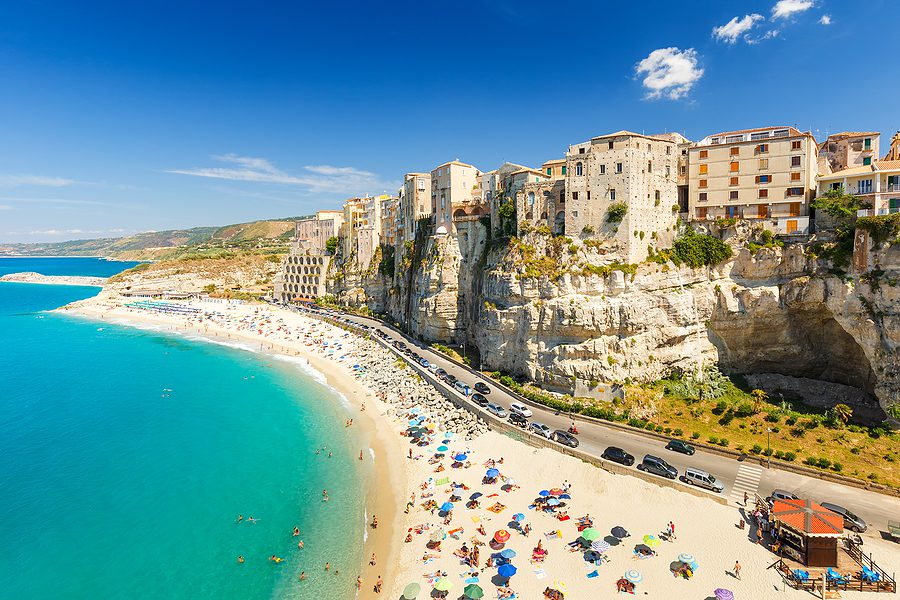
Directly beneath the lofty town of Tropea, overlooking the Tyrrhenian Sea on a stretch known as “La Costa degli Dei—the Coast of the Gods—Marasusa Beach has everything: soft white sand, calm and clear waters, scenic cliffs rising above, and—except in August—few crowds. The coast is marked by dramatic cliffs and rock formations bordered by intensely turquoise waters. There are lots of ways to play in the sea here: you can rent paddleboats, canoes, and rubber boats, and there’s a diving center for snorkeling and scuba diving. At the southern tip of Italy, Calabria is only beginning to see foreign tourists so that it may be the only tourist attraction, such as Tropea’s Norman Cathedral. The town is a four- or five-hour train ride from Naples.
Rimini

What you see at Rimini is what you get—kilometers of white sand washed by mild Adriatic waters and covered with row-on-row of rented beach umbrellas and lounge chairs. It’s an Italian beach resort at its most typical, and that’s how the Italians love their Riviera del Sole. So pay up, flop down, and join the fun. There’s a Coney Island honky-tonk atmosphere here that’s contagious once you get past the idea of renting sand. Across the street behind the beach is a row of hotels of every kind—even the grand hotels you’ll find at old-money resorts like Sanremo, like the luxury Hotel De Londres, with its pool and rooftop spa. Don’t expect to find an available umbrella—or lodging—in August without a booking. While you’re here, stop to see the surprising town of Rimini just inland, a busy Roman colony and port with several Roman sites. Children will love taking a trip through the wonders of Italy, all shrunk to their size at the popular attraction, Italia in Miniatura.
Lido, Venice
Europe’s first absolute beach resort developed on this 12-kilometer barrier island that separates the Venetian lagoon from the Adriatic Sea. Crowned heads of Europe gathered at its grand hotels and Art Nouveau villas, which are still well-kept and glamorous. The hotels also control much of the fine sandy beach, where you can rent an umbrella (or a thatched cabana at the grander of them), although a large section of beach at the island’s north end is open to the public, near the church of San Nicola. Lido is easy to reach by Vaporetto from Venice and worth a trip to see the Art Nouveau fripperies, even when it’s too cold for the beach. Several other beach options surround Venice. Lido di Jesolo is on the mainland east of the city—a functional, purpose-built resort with a good beach but no charm. Farther east at Grado, the beach has more character and is close to the important Roman site of Aquileia. South of the city, famous beaches are at Sottomarina in the Venetian lagoon near the fishing town of Chioggia.
Bonuses
Acquafredda di Maratea Beach
Situated just a short drive from the hamlet of Maratea, Acquafredda di Maratea Beach features crystal clear blue waters and dark gray sand. Vacationers who appreciate rustic beauty should spend a day or two in the area. The rocky shoreline and rugged cliffs make Acquafredda di Maratea Beach such a picturesque destination, so much so that many people come here from all over Europe to take their wedding photographs. Sun loungers and umbrellas are available for rent, and some of the main water activities include swimming and snorkeling. Explore the area’s remarkable caves, but remember that some are only accessible by boat.
Marina Grande Beach
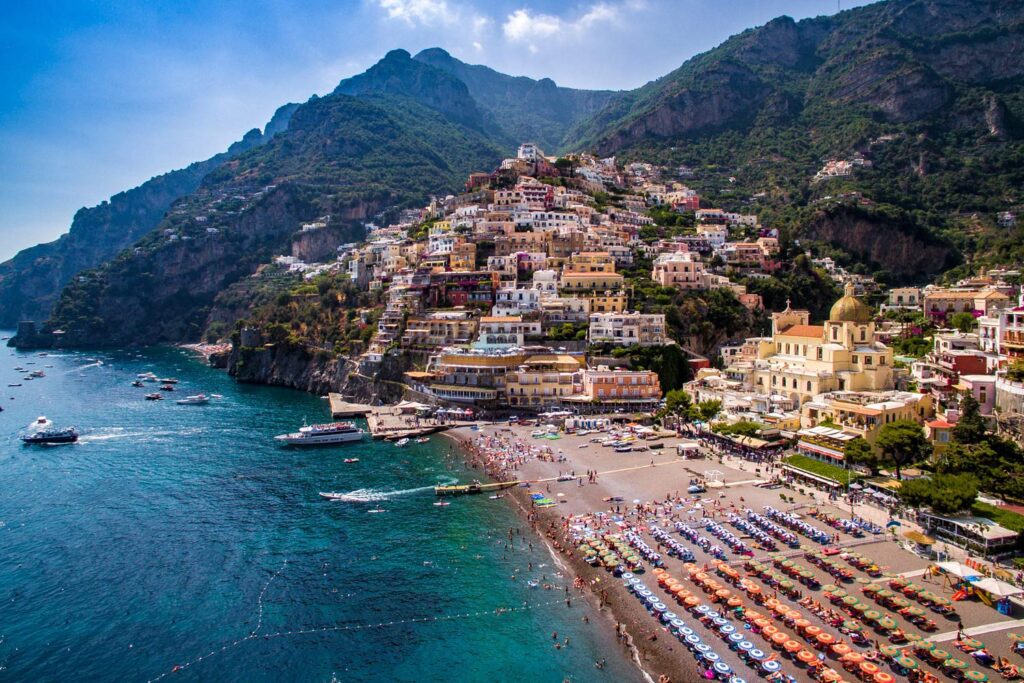
Thanks to its impressive cliffs with pretty pastel houses on top, Marina Grande Beach in Positano is one of the most picturesque beaches in Italy. This cosmopolitan beach on the Amalfi coast is three hundred meters long and attracts large crowds of tourists every summer. The orange and blue lounge chairs and beach umbrellas are tidily arranged but come early in the morning to ensure you do not miss out on a pitch. The area has dozens of restaurants and bars offering fantastic sea views, many popular with local and international celebrities. Marina Grande Beach also offers tourist boat tours, where excursions occur on the surrounding coastline and nearby unexplored bays.
Scalo Maestro
Situated on the small island of Marettimo, which has a population of only 700 residents, Scalo Maestro is a tiny beach known for its calm waters and ideal conditions for snorkeling and swimming. It is one of the few beaches in the area that can be accessed from the shore, and once you’re there, you’ll be amazed by its stunning scenery, often seen in dreamy travel magazines. If you get bored of enjoying the views and swimming in the sea, feel free to charter a boat and tour the island. This is the only way to access the many hidden sea caves worth checking out.
Camogli Beach
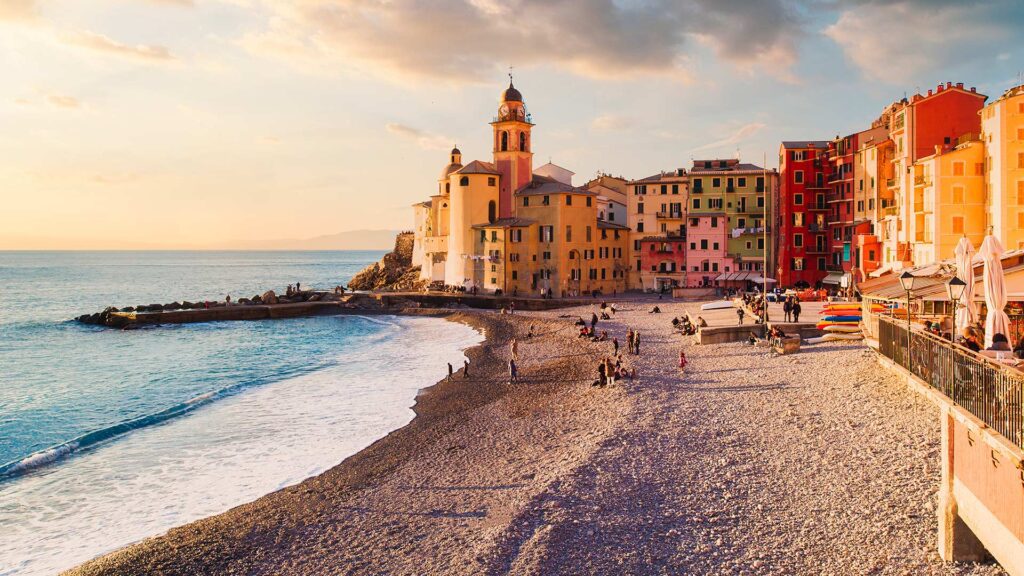
Camogli in Liguria is a lovely tiny coastal village home to a sizeable pebbly beach with that oh-so-familiar exceptional Mediterranean beauty. The great thing about Camogli Beach is that it’s rarely crowded, and you can always find a secluded spot for privacy. It is divided into several private areas that belong to luxurious beach clubs and resorts, but other sections of the beach are open to all visitors. Swimming lessons for children are available on the beach, and for more advanced swimmers, consider taking a full-on diving course. Canoes can be hired to explore the waters, and once out at sea, it is a great way to get to see Camogli Beach from an alternative point of view. A unique selling point to Camogli Beach is if you want to unwind with a drink without leaving the sand, a beachside drink service is also available!
Spiaggia di Tuerredda
One of the most amazing beaches on the southern coast of Sardinia, Spiaggia di Tuerredda, is located near the beach of Su Giudeu and just west of Sa Pinnetta. It’s a natural beauty, and warm waters are two reasons vacationers love spending their summer holidays here. You will find several beachfront bars and restaurants at Spiaggia di Tuerredda and magnificent views of Isola di Tuerredda. Some of the most popular water activities at Spiaggia di Tuerredda include kayaking and paddle boarding. This fantastic beach is also a perfect destination for snorkeling. The only downside to this famous beach is that it gets quite overcrowded during the peak season of July and August.
Dei Due Mari Beach

Dei Due Mari Beach, also known as the “Beach of the Two Seas,” divides the pond of Notteri and the sea. Expect to find clear blue waters, ideal conditions for swimming and snorkeling. If you’re lucky, pink flamingos are common at Dei Due Mari Beach. Travelers can explore the two small creeks at the end of the beach and admire the extraordinary pink sand found on the shore. If you’re feeling adventurous, head out to nearby Simius Beach, which features a long strip of white sand and two picturesque coves.
Mezzavalle Beach
Located in the heart of Conero, Mezzavalle is a fantastic beach decorated with strawberry trees and old oaks. Go to the top of the cliffs, which back the sands, for incredible sea views, then take the steep trails that lead straight to the beach for a day of swimming in the crystal clear waters. Mezzavalle Beach is usually not busy with tourists, making it an ideal location for vacationers looking for privacy. If you love unspoiled nature and don’t care much about beach facilities, Mezzavalle Beach is worth visiting. The beach is accessible by boat or two roads starting from the center of Conero. You will find a small restaurant on the beach that offers a variety of tasty dishes from the region, such as Italian wines and beers.
Gavitella Beach
Situated high up on the cliffs, Praiano is a small picturesque town with a few tiny beaches in tiny coves. One of these beaches is Gavitella Beach, which has two concrete piers and plenty of sandy space for those wishing to sunbathe. This 30-meter-long beach is also famous for its spectacular views of Capri Island. Expect to find a small bar and a restaurant where travelers can grab a drink or order delicious seafood. Remember that to reach the beach, you will need to head down 400 steep steps from the Praiano main square, but once you’re there, you can also enjoy the small natural pool close to Gavitella beach called Fontana dell’Altare.
Rabbit Island

Head to the small but perfectly formed Rabbit Island, best described as rugged and scenic. This island used to be home to thousands of rabbits, which is where its name came from, but today, Rabbit Island is home to several loggerhead turtles. There are so many turtles here that the island was made a marine reserve to protect them and their nesting sites. But we’re here to talk about the beach, and the beach on Rabbit Island is spectacular in every way. The mainland is over 100 miles away, making the island feel remote.










